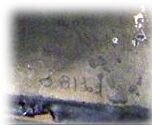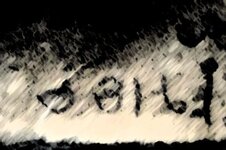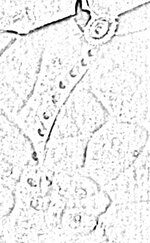Hi folks. Thanks for the chance to finally find something out about this lady here. I bought this in 1999 because I thought it looked like a good piece to resell. I was told by a respected auction house that it would be impossible to sell because these paintings on this type of metal are actually TOO rare and never found in one piece. (This IS in one piece, obviously)
The date on it is _ _-31-61
The month MAY be a 5 or a 6...it's hard to tell.
There is some kind of red enamel pushed into the back of the painting to give it a two dimensional look. Unfortunately bearing the passage of time, this "technique" has just made the woman look as though she's wearing one of those fake-muscle padded wrestling suits! However, it is an interesting technique and I would love to learn more about when/how/why it was used.
Here are some photos- sorry they are so large but I wanted to show as much detail as possible. The painting is about 14x16 (if indeed it IS a "painting" and not some altogether different type of medium) and if ANYONE can oblige, I would dearly love to know *anything* about "the old sourpuss", as we've come to refer to her in my family.
http://nunesadkisson.webng.com/metal_painting_001.jpg - FRONT
http://nunesadkisson.webng.com/metal_painting_003.jpg - FRONT
http://nunesadkisson.webng.com/metal_painting_004.jpg - BACK
http://nunesadkisson.webng.com/metal_painting_sig2.jpg - SIGNATURE/DATE
The painting is HEAVY to be this size. Unfortunately, I do not have the original frame. It was apparently very ornate and expensive; the man I purchased the painting from sold the frame separately and actually FOLDED this metal sheet and stored it for decades. It's amazing that it's in one piece, as the metal bends and twists every which way when you lift any part of it. My dad thinks it's lead but I have no idea as to the type of metal, myself.
Oh, one last note- I purchased this in Connecticut in 1999. It was said to have originally "lived" in Pennsylvania, although I was not told what part. It had been in Connecticut since at least 1932, I do know that much. (Well, I was TOLD that much...it could be completely inaccurate for all I know)
If anyone can help me identify anything about this piece, I would be sincerely grateful. I have grown really curious over the years having never been able to find ANYTHING about this style of artwork, so I would be grateful for ANY resource of information, no matter how insignificant.
Thank you, everyone.
-Liz
The date on it is _ _-31-61
The month MAY be a 5 or a 6...it's hard to tell.
There is some kind of red enamel pushed into the back of the painting to give it a two dimensional look. Unfortunately bearing the passage of time, this "technique" has just made the woman look as though she's wearing one of those fake-muscle padded wrestling suits! However, it is an interesting technique and I would love to learn more about when/how/why it was used.
Here are some photos- sorry they are so large but I wanted to show as much detail as possible. The painting is about 14x16 (if indeed it IS a "painting" and not some altogether different type of medium) and if ANYONE can oblige, I would dearly love to know *anything* about "the old sourpuss", as we've come to refer to her in my family.
http://nunesadkisson.webng.com/metal_painting_001.jpg - FRONT
http://nunesadkisson.webng.com/metal_painting_003.jpg - FRONT
http://nunesadkisson.webng.com/metal_painting_004.jpg - BACK
http://nunesadkisson.webng.com/metal_painting_sig2.jpg - SIGNATURE/DATE
The painting is HEAVY to be this size. Unfortunately, I do not have the original frame. It was apparently very ornate and expensive; the man I purchased the painting from sold the frame separately and actually FOLDED this metal sheet and stored it for decades. It's amazing that it's in one piece, as the metal bends and twists every which way when you lift any part of it. My dad thinks it's lead but I have no idea as to the type of metal, myself.
Oh, one last note- I purchased this in Connecticut in 1999. It was said to have originally "lived" in Pennsylvania, although I was not told what part. It had been in Connecticut since at least 1932, I do know that much. (Well, I was TOLD that much...it could be completely inaccurate for all I know)
If anyone can help me identify anything about this piece, I would be sincerely grateful. I have grown really curious over the years having never been able to find ANYTHING about this style of artwork, so I would be grateful for ANY resource of information, no matter how insignificant.
Thank you, everyone.
-Liz


 .
.  I'll keep looking, and maybe some others will be able to help out.
I'll keep looking, and maybe some others will be able to help out. 

 ) I got to playing with the pictures on photoshop since I'm at work and have nothing better to do. Anyway, I pulled some color out, did a photocopy, etc, etc etc. and on the buttons the only thing I can make out is at the bottom, and I'm not sure that anything is there. I was judging by the brushstrokes that they look about the same as the top, but the "e" is accidentally spaced and the "c or u" is a mis-stroke. There's what appears to be an "s" on the right side of the buttonseam, but if you look at it in one of the RGB settings, I think it happened because of what's on the back of the painting. I never could figure out how to save it in the colors that I wanted to, I still have to learn how to use it better anyway.
) I got to playing with the pictures on photoshop since I'm at work and have nothing better to do. Anyway, I pulled some color out, did a photocopy, etc, etc etc. and on the buttons the only thing I can make out is at the bottom, and I'm not sure that anything is there. I was judging by the brushstrokes that they look about the same as the top, but the "e" is accidentally spaced and the "c or u" is a mis-stroke. There's what appears to be an "s" on the right side of the buttonseam, but if you look at it in one of the RGB settings, I think it happened because of what's on the back of the painting. I never could figure out how to save it in the colors that I wanted to, I still have to learn how to use it better anyway.





